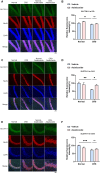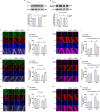Asiaticoside Attenuates Chronic Restraint Stress-Induced Hippocampal CA1 Neuronal Ferroptosis via Activating BDNF/Nrf2/GPX4 Signaling Pathway
- PMID: 39931216
- PMCID: PMC11808218
- DOI: 10.2147/DDDT.S509208
Asiaticoside Attenuates Chronic Restraint Stress-Induced Hippocampal CA1 Neuronal Ferroptosis via Activating BDNF/Nrf2/GPX4 Signaling Pathway
Abstract
Purpose: Ferroptosis, characterized by iron-dependent lipid reactive oxygen species accumulation, plays a critical role in the pathophysiology of depression. Our research aims to elucidate the potential antidepressant mechanisms of asiaticoside, a bioactive compound known for its neuroprotective and immunomodulatory properties.
Methods: The antidepressant-like properties of asiaticoside in a model of chronic restraint stress (CRS)-induced depression in mice, with a particular focus on its interaction with ferroptosis-related pathways.
Results: The behavioral results revealed that asiaticoside significantly ameliorated CRS-induced depressive symptoms, as evidenced by increased sucrose preference and reduced immobility time. At the molecular level, asiaticoside enhanced the expression of brain-derived neurotrophic factor (BDNF), phosphorylated tropomyosin receptor kinase B (pTrkB), phosphorylated nuclear factor erythroid 2-related factor 2 (pNrf2), glutathione peroxidase 4 (GPX4), and solute carrier family 7 member 11 (SLC7A11), indicating its neuroprotective and antioxidative effects. In addition, asiaticoside suppressed the expression of ferroptosis markers, including ferritin light chain (FLC) and transferrin receptor only in CA1 region. Transmission electron microscopy (TEM) further confirmed that asiaticoside preserved mitochondrial integrity in CA1 neuronal cells.
Conclusion: In conclusion, our findings suggest that asiaticoside exerts its antidepressant-like effects through the modulation of BDNF/Nrf2/GPX4 signaling pathway against neuronal ferroptosis in the hippocampal CA1 region.
Keywords: BDNF; GPX4; Nrf2; antidepressant; asiaticoside; ferroptosis.
© 2025 Zhou et al.
Conflict of interest statement
The authors declare that there is no conflict of interest.
Figures











References
MeSH terms
Substances
LinkOut - more resources
Full Text Sources
Medical
Miscellaneous

